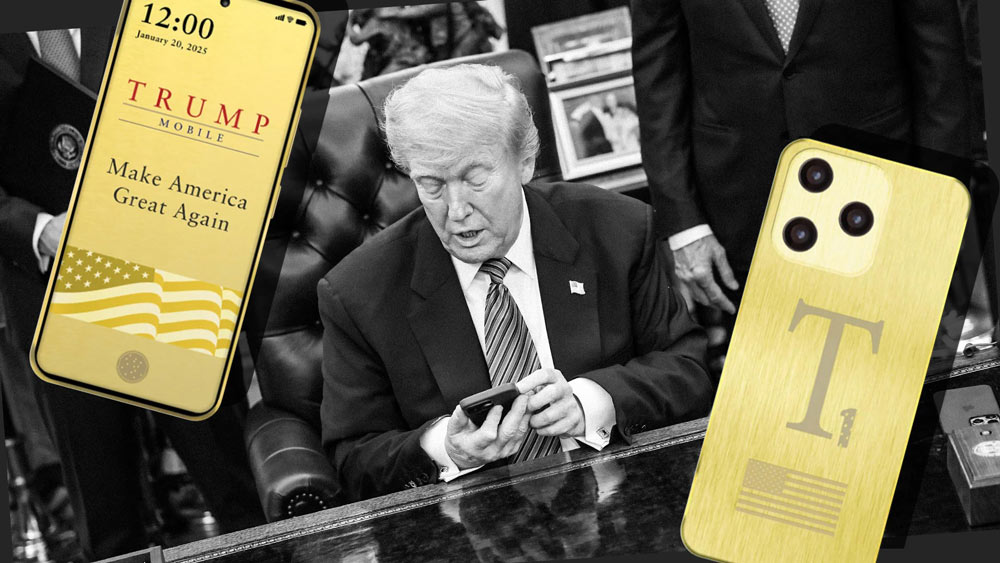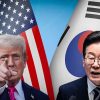The Trump Organization’s latest venture into the technology market, a smartphone named the “Trump T1,” has sparked widespread discussion among experts and analysts. Officially unveiled on Monday, the gold-colored device has been branded as an affordable and American-made alternative to current flagship smartphones. However, industry experts are skeptical about the feasibility of manufacturing such a device solely in the United States, pointing instead to China as the likely production hub.
Bold Claims, Contradictory Realities
Priced at $499, the Trump T1 is marketed as being “built in the United States,” in line with former President Donald Trump’s long-standing advocacy for domestic manufacturing. The announcement aligns with broader efforts by Trump to pressure companies like Apple to shift production of their flagship products to American soil, a move he has long championed as critical to revitalizing U.S. manufacturing.
Despite these claims, experts argue that the smartphone’s production will almost certainly rely on Chinese companies. Francisco Jeronimo, vice president at International Data Corporation, told CNBC that it is “completely impossible” for the T1 to be entirely designed or assembled in the U.S. Instead, analysts believe the Trump T1 will be manufactured by a Chinese Original Device Manufacturer (ODM), a common practice in the smartphone industry.
“Despite being advertised as an American-made phone, it is likely that this device will be initially produced by a Chinese ODM,” said Blake Przesmicki, an analyst at Counterpoint Research. Echoing this sentiment, Jeff Fieldhack, another Counterpoint Research expert, pointed out that the U.S. currently lacks the infrastructure and capacity to handle large-scale smartphone manufacturing.
A Global Supply Chain
Even if some assembly or production were to take place in the U.S., the smartphone would still rely heavily on components from around the world, highlighting the inherently global nature of smartphone supply chains.
The Trump T1’s specifications, which include a 6.8-inch AMOLED display and a 50-megapixel camera, provide a glimpse into its likely component sources. AMOLED screens are primarily manufactured by South Korean giants Samsung and LG, with Chinese company BOE also producing similar displays. Likewise, the processor for the T1 is expected to come from Taiwanese firm MediaTek or Qualcomm, both of which rely on manufacturing facilities in Taiwan.
The camera technology, particularly image-sensing chips, is another area where foreign expertise dominates. Japanese company Sony leads this market, with smaller competitors based in China and other countries. Memory components could potentially come from U.S.-based Micron, but South Korea’s Samsung remains a strong candidate for this aspect of the device.
A Price that Reflects Reality
The Trump T1’s $499 price tag has also raised eyebrows. For comparison, Apple’s iPhone 16 Pro Max, which features a slightly larger 6.9-inch display, starts at $1,199. Given the T1’s lower price point, analysts believe it will likely include mid-tier components to keep costs down. This further reinforces the likelihood of significant reliance on international suppliers, particularly in countries with lower manufacturing costs.
The Broader Context
The announcement of the Trump T1 comes amid heightened scrutiny of global supply chains and the geopolitical tensions between the U.S. and China. While President Trump’s push for more domestic manufacturing has been a central theme of his economic agenda, experts point out that creating a robust U.S.-based electronics manufacturing industry would take years, if not decades, to achieve.
“Even when there is local manufacturing available, the company will have to rely on components that are being imported from outside the U.S.,” said Fieldhack. This reality underscores the challenges of producing complex devices like smartphones domestically at competitive prices.
What Lies Ahead for the Trump T1?
As the Trump T1 enters the market, it will undoubtedly attract attention for its branding and the political implications of its production. Whether it can deliver on its promise of being a truly American-made smartphone remains to be seen. For now, industry insiders remain skeptical, viewing it as another example of how globalized the technology sector has become — and how difficult it is to shift those dynamics overnight.
While the Trump Organization continues to tout the T1 as an emblem of American manufacturing, the facts suggest a more nuanced story, one that reflects the complex interplay of global supply chains, cost-effective production, and technological innovation.











